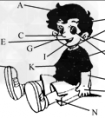根据汉语或首字母提示填写单词。1. If we don't take action to protect polar bear, they will be in ______ (危险).2. Do you want to ______ (加入) the Birdwatchin-八年级英语
Tom runs as fast as Mike.汤姆和迈克跑得一样快。
Tom runs twice as fast as Mike.汤姆跑得速度是迈克的二倍。
(2)“甲+助动词+not+动词原形+as/so+副词原级+as+乙”甲不如乙…例如:
He doesn’t walk as slowly as you.他走路不像你那样慢。
二、比较级的用法
1.可以修饰比较级的词,much,a lot,far,…的多; a little,a bit,…一点儿; even甚至;;still仍然。例如:
Lesson One is much easier than Lesson Two.第一课比第二课容易得多。
Tom looks even younger than before.汤姆甚至比以前更年轻。
This train runs much faster than that one.这辆火车比那辆跑地快。
She drives still more carefully than her husband.她开车仍然比她丈夫还认真。
2.比较级常用的句型结构
(1)“甲+实意动词+(倍数)+副词比较级+than+乙”表示“甲比乙…”或“甲比乙…几倍”。例如:
I got up earlier than my mother this morning.我今天早晨起床比我妈妈还早。
He runs three times faster than his brother.他跑的速度比他弟弟快三倍。
(2)“甲+实意动词+副词比较级+than+anyother+单数名词(+介词短语)”表示“甲比同一范围的任何一个人/物都……”,含义是“甲最……”。例如:
Mike gets to school earlier than any other student in his class.
= Mike gets to school earlier than any of the other students in his class.迈克比他们班上任何一个其他的同学到校都早。
= Mike gets to school earlier than the other students in his class.迈克比他们班上其他的同学到校都早。
= Mike gets to school earliest in his class.迈克在他们班到校最早。
注意:Mike gets to school earlier than any student in Tom’s class.迈克比汤姆班上任何一个学生到校都早。(迈克和汤姆不是同一个班)
(4)“比较级+and+比较级”表示“越来越……”。例如:
He is getting taller and taller.他变得越来越高了。
The flowers are more and more beautiful.花儿越来越漂亮。
He does his homework more and more carefully.他做作业越来越认真了。
(5)“the+比较级,the+比较级”表示“越……,越……”。例如:
The more careful you are,the fewer mistakes you’ll make.你越认真,犯的错误越少。
(6)“特殊疑问词+实意动词+副词比较级,甲or乙?”例如:
Who draws better,Jenny or Danny?谁画得比较好,詹妮还是丹尼?
三、最高级的用法
最高级常用句型结构
(1)“主语+实意动词+(the)+副词最高级+单数名词+in/of短语”表示“……是……中最……的”。例如:
I jump (the) farthest in my class.我是我们班跳得最远的。
(2) “特殊疑问词+be+the+副词最高级+甲,乙,or丙?”用于三者以上的比较。例如:
Which season do you like (the) best,spring,summer or autumn?你最喜欢哪一个季节,春天,夏天还是秋天?
(3)“特殊疑问词+be+the+最高级+甲,乙,or丙?”用于三者以上的比较。例如:
Which country is the largest,China,Brazil or Canada?哪一个国家最大,中国,巴西还是加拿大?
考点名称:分词
- 分词:
就是具有动词及形容词二者特征的词;尤指以-ing或-ed,-d,-t,-en或-n结尾的英语动词性形容词,具有形容词功能,同时又表现各种动词性特点,
如时态,语态、带状语性修饰语的性能及带宾语的性能。
分词分为现在分词和过去分词两种,是一种非谓语动词形式。
现在分词和过去分词主要差别在于:
现在分词表示"主动和进行",过去分词表示"被动和完成"(不及物动词的过去分词不表示被动,只表示完成)。
分词可以有自己的状语、宾语或逻辑主语等。 现在分词构成形式:
①一般在动词原形末尾加ing,如do→doing、sing→singing、comfort→comforting
②以不发音的e、ue结尾的动词,先去e,再加ing,如dance→dancing、hike→hiking、write→writing、make→ making,take→taking
③以ee、oe、ye结尾的动词加ing,如see→seeing、toe→toeing、dye→dyeing
④以重读闭音节结尾的动词,并且末尾只有一个辅音字母,应双写这一字母,再加ing,如cut→cutting、swim→swimming
注:结尾是x则不必双写,如relax→relaxing
⑤以ie结尾的动词,要把ie变成y再加ing,如die→dying,lie→lying.
⑥以ic结尾的动词,要把ic变成ick再加ing,如picnic→picnicking,traffic→trafficking过去分词构成形式:
1.规则动词:规则动词的过去分词的构成规则与规则动词的过去式的构成规则相同。四点变化规则:
(1)、一般动词,在词尾直接加“ ed ”。(然而要注意的是,过去分词并不是过去式)
work---worked---worked , visit---visited---visited
(2)、以不发音的“ e ” 结尾的动词,只在词尾加“ d ”。
live---lived---lived
(3)、以“辅音字母 + y ”结尾的动词,将 "y" 变为 "i" ,再加“ ed ”。
study---studied---studied,cry---cried---cried,try---tried---tried,fry---fried---fried.[1]
(4)、重读闭音节结尾,末尾只有一个辅音字母,先双写该辅音字母,再加“ ed ”。
stop---stopped---stopped , drop---dropped--dropped
(5)、以ic结尾的动词,要把ic变成ick再加ed,
picnic→picnicked ,traffic→trafficked
2 、不规则动词:见不规则动词表分词用法:
1、分词作状语
分词在句子中作状语,可以表示时间、条件、原因、结果、让步、伴随等。
分词(短语)作状语时,其逻辑主语应与句中主语相一致。
当现在分词表示的动作发 生在谓语动词之前时, 则用现在分词的完成式,且所表示动作与谓语动作同时发生, 则用现在分词的一般式。
完成或被动关系用过去分词。
①现在分词:
The students went out of the classroom, laughing and talking.
②过去分词:
Accompanied by his friend, he went to the railway station.
Given better attention, the plants could grow better.
2、“while ( when, once, until, if , though等连词)+分词”结构
现在分词或过去分词作状语时,有时可以在分词前加while,when, once, although, until, if等连词。
①现在分词:
When leaving the airport, she waved again and again to us.
While waiting for the train, I had a long talk with my sister about her work……
②过去分词:
Once recovered, he threw himself into his work and made every effort to do it well.
Although working very hard, he failed to pass the final exam. If translated word by word, the passage will be difficult to understand.
3、分词作定语
分词作定语时,单个的分词通常放在被修饰的名词之前,分词短语一般置于所修饰的中心词后面。
现在分词修饰的是发出该动作的名词(即与名词有主谓关系),过去分词修饰承受该动作的名词(即与名词是动宾关系)。
We will go on with our experiment as soon as we get the added fund.
This is really an exhausting day to all of us!
We can see the part of the moon lighted by sunlight.
After a night spent in excitement and sleeplessness, I forced myself to take a long walk along the beach the next day.
More and more developing countries established strategic partnership with developed countries
4、分词作宾语补足语
现在分词在see, watch, hear, observe, notice, feel, find, glimpse, glance等感官动词和look at, listen to等短语动词以及
have, keep, get, catch, leave, set, start, send等使役动词后面与名词或代词构成复合宾语,作宾语补语的成分。
例:I see him passing my house every day.
I caught him stealing things in that shop.
I smelt something burning.
5、分词作表语
分词作表语通常看作形容词来用。
过去分词表示主语的感受或状态,主语多为人。现在分词表示主语的性质,而且主语多为物;
①过去分词:
We were so bored that we couldn’t help yawning.
She felt confused, and even frightened.
②现在分词:
He was very amusing.
That book was rather boring.
很多动词的现在分词都可以作表语:
exciting, interesting, encouraging, disappointing, confusing, touching, puzzling.
- 最新内容
- 相关内容
- 网友推荐
- 图文推荐
| [家长教育] 孩子为什么会和父母感情疏离? (2019-07-14) |
| [教师分享] 给远方姐姐的一封信 (2018-11-07) |
| [教师分享] 伸缩门 (2018-11-07) |
| [教师分享] 回家乡 (2018-11-07) |
| [教师分享] 是风味也是人间 (2018-11-07) |
| [教师分享] 一句格言的启示 (2018-11-07) |
| [教师分享] 无规矩不成方圆 (2018-11-07) |
| [教师分享] 第十届全国教育名家论坛有感(二) (2018-11-07) |
| [教师分享] 贪玩的小狗 (2018-11-07) |
| [教师分享] 未命名文章 (2018-11-07) |






